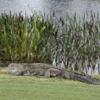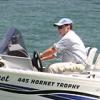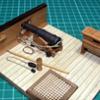MORE HANDBOOKS ARE ON THEIR WAY! We will let you know when they get here.
×

JerseyCity Frankie
-
Posts
1,338 -
Joined
-
Last visited
Reputation Activity
-
 JerseyCity Frankie reacted to philipjames in USS Constitution by SgtSki in MI - Revell - 1:96 - PLASTIC
JerseyCity Frankie reacted to philipjames in USS Constitution by SgtSki in MI - Revell - 1:96 - PLASTIC
Been looking into the history of this kit, the original 1965 release was Catalogue number H-386 and came without sails. In 1968 Revell added Cat No. H-398 which is the version with sails. Up until 1972 both versions were in the Revell Catalogue (the version with sails was more expensive).
The box art was changed to the one GLakie shows in his post in 1976
There was a third version produced - the 'Museum Classic' version from 1979 which had a prepainted copper hull, a wooden base with a brass plated nameplate and brass plated pedestals for the ship to stand on together with flock coated vac formed sails which were advertised as 'Realistic Cloth Like Sails"
-
 JerseyCity Frankie reacted to SgtSki in MI in USS Constitution by SgtSki in MI - Revell - 1:96 - PLASTIC
JerseyCity Frankie reacted to SgtSki in MI in USS Constitution by SgtSki in MI - Revell - 1:96 - PLASTIC
OK here we go...
3 January, 2015. Thus begins my build log of Revell's 1:96 scale USS Constitution. I selected an older kit release because a lot of things I've read indicate that they have much higher molding quality over the newer kits. Mine has a box date of 1974 and it has a US Bicentennial logo, so I believe that it was produced between 1974 and 1976. I plan on "kinda" building her as she appeared under Isaac Hull's command. I say "kinda" because I'm not going into every particle of minutiae involved with how she really was configured. I'm just taking care of the obvious such as eliminating the forward gunport (bridle port) and the skylight above the Captain's cabin. Other than that this will pretty much be an out-of-box build. Feel free to follow along!
-
 JerseyCity Frankie reacted to Omega1234 in Lennox by Omega1234 - FINISHED - 1/192 - 17th Century Warship
JerseyCity Frankie reacted to Omega1234 in Lennox by Omega1234 - FINISHED - 1/192 - 17th Century Warship
Hi all. Thanks to all for the Likes so far! Here are some more photos. These are mainly of the decks and bulkheads, etc. Future build logs will show the masts, bowsprit, figurehead, gold decorative work and the rigging (which I must admit, is the thing I enjoy the least and regularly stuff up the most!!). Anyhow, pls enjoy these photos first.
-
 JerseyCity Frankie reacted to Omega1234 in Lennox by Omega1234 - FINISHED - 1/192 - 17th Century Warship
JerseyCity Frankie reacted to Omega1234 in Lennox by Omega1234 - FINISHED - 1/192 - 17th Century Warship
More internal accommodation details:
-
 JerseyCity Frankie reacted to Omega1234 in Lennox by Omega1234 - FINISHED - 1/192 - 17th Century Warship
JerseyCity Frankie reacted to Omega1234 in Lennox by Omega1234 - FINISHED - 1/192 - 17th Century Warship
Hi everyone. Some more photos.
-
 JerseyCity Frankie reacted to Omega1234 in Lennox by Omega1234 - FINISHED - 1/192 - 17th Century Warship
JerseyCity Frankie reacted to Omega1234 in Lennox by Omega1234 - FINISHED - 1/192 - 17th Century Warship
Hello everyone. Although my model of the 17th Century 70 gun Restoration Warship, Lennox, was completed in mid 2013, I've decided to do this build log for two reasons, one for instructive purposes (to show how NOT to do things) and secondly, as a means to offer the plans to anyone who's interested (first come, first serve). If you are interested in the plans, then pls let me know.
About the model: The model is built in Admiralty style, with large parts of the hull cutaway and deck exposed so that the interior work can be viewed. The hull is approximately 29 cms long, or 36 cm including the bowsprit. For the sake of clarity, I'll include photos starting from the bare framed hull, through to the finished model over a series of build logs.
Hope you enjoy. Comments and feedback welcomed as always.
The first photos start with the framed hull and further progress on the internal structures will appear in the following build logs.
-
 JerseyCity Frankie reacted to foxy in HMS Victory by foxy - Heller - 1/100 - PLASTIC - with Dafi's etch & resin set
JerseyCity Frankie reacted to foxy in HMS Victory by foxy - Heller - 1/100 - PLASTIC - with Dafi's etch & resin set
Well its a busy time and found some brass/stainless rings for hanging the anchors.
With black rope raped around ring and later will add cotton thread for seizing, also plastic strips that come with Dafis resin anchors glued around wood plinths.
Next it was the crest to finish, not to happy with this as the lions are not very good,(old Mold I expect).
Made up the ships bell with Dafis etch and extra brass rod to allow the bell to swing later.
I assume that the handle on the top has a pull rope attached, anyone Know if this is correct???.
Last pictures are the catheads added crown to front that comes with the kit.
More later
Frank
-
 JerseyCity Frankie reacted to Patrick Matthews in Cargo Winch
JerseyCity Frankie reacted to Patrick Matthews in Cargo Winch
I needed some in 1:48 too, so I designed and 3D-printed them. An anchor windlass too. And the stud link anchor chain.
Not having any reliable drawings or images to go by, they had to be figments and overly simplified at that. But good enough for this job, a waterline model on a railroad layout.
I do wish I had access to good drawings of such gear, would love to work up some better designs.
-
 JerseyCity Frankie reacted to Keith_W in Mutiny on the Bounty
JerseyCity Frankie reacted to Keith_W in Mutiny on the Bounty
In my recent trip to the UK I stumbled across this. This is what I love about London - so much history, and the possibility you might happen upon somewhere where famous feet have trodden on!
Looks like you will need to put a flatscreen TV and a reading lamp on your Bounty Launch, Cap'n!
-
 JerseyCity Frankie got a reaction from druxey in Pin Rails
JerseyCity Frankie got a reaction from druxey in Pin Rails
My two or three cents about pins and pinrails: Use the smallest possible pin you can find or make, this will prevent a cascading series of scale issues from developing later. Obviously the smaller the pins, the more can be fit on a rail. Every pinrail I have seen has the pins spaced evenly about 10" apart. Any closer together and the belayed lines passed around the pins would interfere with each other and the sailors couldn't get their hands in there.
Most of the pins I see on models are too big and have en exaggerated shape and if scaled up would look like three foot high wooden lightbulbs. Most actual pins are two inches wide at most and are seldom longer than 18". They do flare out on their upper halves, but only a bit and a human hand can still grasp them- the commercially available ones all too often flare out into nearly spherical globes. Also consider that once there is a line on the pin, the pin itself is no longer visible except maybe its very top. For this reason I mostly just use wire or rod.
An issue that always arises is the apparent low number of pins, modelers often find their accurate plans do not provide enough places for all the lines to belay to. This is a very common problem.
As mentioned above, another very common problem is not fixing your pinrail strongly enough. There isn't very much tension on them but the pinrails on models do very often pull out or distort from the accumulated strain placed on them by the rigging, which apparently over time can contract.
-
 JerseyCity Frankie got a reaction from allanyed in Pin Rails
JerseyCity Frankie got a reaction from allanyed in Pin Rails
My two or three cents about pins and pinrails: Use the smallest possible pin you can find or make, this will prevent a cascading series of scale issues from developing later. Obviously the smaller the pins, the more can be fit on a rail. Every pinrail I have seen has the pins spaced evenly about 10" apart. Any closer together and the belayed lines passed around the pins would interfere with each other and the sailors couldn't get their hands in there.
Most of the pins I see on models are too big and have en exaggerated shape and if scaled up would look like three foot high wooden lightbulbs. Most actual pins are two inches wide at most and are seldom longer than 18". They do flare out on their upper halves, but only a bit and a human hand can still grasp them- the commercially available ones all too often flare out into nearly spherical globes. Also consider that once there is a line on the pin, the pin itself is no longer visible except maybe its very top. For this reason I mostly just use wire or rod.
An issue that always arises is the apparent low number of pins, modelers often find their accurate plans do not provide enough places for all the lines to belay to. This is a very common problem.
As mentioned above, another very common problem is not fixing your pinrail strongly enough. There isn't very much tension on them but the pinrails on models do very often pull out or distort from the accumulated strain placed on them by the rigging, which apparently over time can contract.
-
 JerseyCity Frankie reacted to Cristiano in Venetian Polacre by Cristiano - FINISHED - XVIII century
JerseyCity Frankie reacted to Cristiano in Venetian Polacre by Cristiano - FINISHED - XVIII century
THE SAIL PLAN
After evaluating the historical period and other similar projects, I decided that the sail plan can be rather similar to the one made by Amati Venetian Polacre.
Other plans exist of other polacres of other countries, and the sail size are all more or less the same.
below can be seen some of the sail plans and rigging that I made with a CAD program.
I superimposed the orignal hull drawing.
The rigging is a rather complex part.
In the photos only few of the rigging that I made is showed.
Luckily, in the mid XVIII century the sail rigging was rather standardised, so I must not make too much odd hypotesis.
Note: I mirrored the top view of the hull, and evenly corrected, the drawing is still not correct.
So it means that the original drawing was probably focused on the hull drawing and only lighty on the bridges details.
-
 JerseyCity Frankie reacted to Cristiano in Venetian Polacre by Cristiano - FINISHED - XVIII century
JerseyCity Frankie reacted to Cristiano in Venetian Polacre by Cristiano - FINISHED - XVIII century
More than 20 years ago I built from scratch a venetian xebec, from purchased plans.
The plans are available but are not made by the usual ships manufacturers.
They were made accordingly to original drawings coming from a Venetian archive.
In the photos can be seen some of the plans and the model that I made.
The model is rather big (around 90 cm long).
I always been puzzled by the strange shape of such xebec (a bit fat, hull not common on xebec).
Now finally I have found the original ancient drawings that originated such plans!
They are published in the book "Venetian Ships - Navi Veneziane" by Gilberto Penzo, Lint editor.
I discovered that the ship was a polacre, and the absence of sail plan probably generated some misunderstanding on the author of the plans thay I purchased.
The original drawings were a bit different and the typical polacre hull is more evident.
After that I decided to study a deep conversion of the model, in order to let it be more similar to the original one.
in the photos:
-one of the purchased plans, made in 1947 (first two photos).
-the original drawings (second two photos)
-the present model.
Well, I am not a true expert, but the final result will be less historically false than the present one, so in anycase will be a success for me!
Any critics to the project (even destructive critics!) and suggestions are always appreciated!
-
 JerseyCity Frankie reacted to Cristiano in Venetian Polacre by Cristiano - FINISHED - XVIII century
JerseyCity Frankie reacted to Cristiano in Venetian Polacre by Cristiano - FINISHED - XVIII century
My shipyard is open again!
Now I am focusing on the standing rigging of the foremast.
-I installed two other cannons (10 more to be installed).
In one of the photos can be seen the single, double and multiple blocks that are needed for this section (one side only), in addition to the toggles for securing them to the deck.
-In other photos is shown how the cables of the standing rigging are secured to the top of the foremast.
I followed the various xebecs and galleys ancient drawings and models.
In the other photos are showed some of the them already installed.
In order to do so, I needed to prepare the ropes and blocks almost completely, before glueing them to the deck (other photos), otherwise the space available for making the various knots was not enough.
More will follow in the next days.
-
 JerseyCity Frankie got a reaction from jud in Animated Knots
JerseyCity Frankie got a reaction from jud in Animated Knots
I'm a huge knot nerd and I am glad to see a conversation here about knots. Naturally, sailors are the best at tying knots and ship model builders can only benefit by learning some of the knots of the sailor. Model builders though probably only need to know a very few knots in order to aid in rigging their ships. The Overhand Knot and the Clove Hitch being the two absolute essentials. I am a big promoter of the Constrictor Knot too as I think it easily has a place among the "top ten" most useful knots. If I was to make a short list of "least know but most useful knots" the Constrictor would be my only submission.
Sailors will argue endlessly about which are the ten knots everyone on a ship should know. They all agree the Bowline, Clove Hitch, Reef Knot, Sheet Bend and Rolling Hitch should be on the list but will begin to argue about what the other five should be. There are so many choices. Personally I would leave the Sheet Bend off the list but I know this is a heretical opinion. I just never have any confidence in it as I have too often seen it misbehave in different types of line.
-
 JerseyCity Frankie got a reaction from Rick01 in HM Mermaid Rigging questions (edited by admin)
JerseyCity Frankie got a reaction from Rick01 in HM Mermaid Rigging questions (edited by admin)
I have worked on actual schooners and there are occasions when the Throat and Peak hailyards are taken off the gaff in order to be used to lift very heavy objects aboard. In fact this process is used for every uprig and downrig since its the best way to rig the spars on and off the boat. I image moving the guns on a cutter would be greatly simplified this way. If you think about it it makes a great deal of sense since the tackle is all set up, the crew is VERY accustomed to its use and its located perfectly. Having hooks makes its use that much easier.
-
 JerseyCity Frankie got a reaction from hornet in Pin Rails
JerseyCity Frankie got a reaction from hornet in Pin Rails
My two or three cents about pins and pinrails: Use the smallest possible pin you can find or make, this will prevent a cascading series of scale issues from developing later. Obviously the smaller the pins, the more can be fit on a rail. Every pinrail I have seen has the pins spaced evenly about 10" apart. Any closer together and the belayed lines passed around the pins would interfere with each other and the sailors couldn't get their hands in there.
Most of the pins I see on models are too big and have en exaggerated shape and if scaled up would look like three foot high wooden lightbulbs. Most actual pins are two inches wide at most and are seldom longer than 18". They do flare out on their upper halves, but only a bit and a human hand can still grasp them- the commercially available ones all too often flare out into nearly spherical globes. Also consider that once there is a line on the pin, the pin itself is no longer visible except maybe its very top. For this reason I mostly just use wire or rod.
An issue that always arises is the apparent low number of pins, modelers often find their accurate plans do not provide enough places for all the lines to belay to. This is a very common problem.
As mentioned above, another very common problem is not fixing your pinrail strongly enough. There isn't very much tension on them but the pinrails on models do very often pull out or distort from the accumulated strain placed on them by the rigging, which apparently over time can contract.
-
 JerseyCity Frankie got a reaction from edmay in The Constrictor Knot
JerseyCity Frankie got a reaction from edmay in The Constrictor Knot
It’s a natural for ship model builders in that you can tie it in your hands even in very small line. In these photos I’m using heavier line in order to make it visible. First form an overhand loop. Note that in the photo there is a prominent loop and the two ends of the line. For the purposes of this demonstration you should think of the two ends of the line as a horizontal bar that will always remain straight. This imaginary bar is never manipulated with the fingers, only the loop is involved in tying the knot.
-
 JerseyCity Frankie got a reaction from BANYAN in The Constrictor Knot
JerseyCity Frankie got a reaction from BANYAN in The Constrictor Knot
Here is the finished knot drawn up on a cylinder. Its nearly the same knot as the Clove Hitch but it stays tight when you pull on the ends and I actually find it easier to tie. If your tying a pair of shrouds or backstays you can tie it in the center of the line and the ends can lead port and starboard.
-
 JerseyCity Frankie got a reaction from CaptainSteve in The Constrictor Knot
JerseyCity Frankie got a reaction from CaptainSteve in The Constrictor Knot
I’m a big fan of the Constrictor Knot. It’s a very useful knot for fixing a line to a spar such as in the case of a stay or backstay attaching to a topgallant masthead on small models or on lighter lines on larger models. Its got a low profile and its easy to tie and when tightened it constricts as advertised. Clifford Ashley apparently invented it and its number 1249 in his book. It’s also mentioned in the original Ship Modelers Shop Notes in a Merritt Edson essay on page 187. Unfortunately the illustration included in Shop Notes tends to make the knot look difficult to tie. In fact most descriptions of the knot fail to show how easily it can be tied. Its litterly just a loop that is twisted once into a figure eight and the two lobes thus created are folded together to form the knot which can be slipped over the end of the spar in question. If the knot has a drawback it is that once tightened it can be very difficult, if not impossible, to untie. This photo shows the steps involved in tying it and below I will break down the individual steps. It may appear complex but it really boils down to a few simple hand moves.
-
 JerseyCity Frankie got a reaction from thibaultron in how to work with teeny blocks???
JerseyCity Frankie got a reaction from thibaultron in how to work with teeny blocks???
I use the Constrictor Knot in these situations. Its a very simple, very compact, very strong knot perfect for seizing. Here is a tutorial I put up a while back on the most simple method of tying this great useful knot: http://modelshipworld.com/index.php/topic/4029-the-constrictor-knot/?hl=constrictor
Tie the constrictor ahead of time in the small stuff you are using for the seizing, don't pull the knot tight yet, leave the loops wide open. Pass a bight of the heavier thread you are using for the blocks strop THROUGH the Constrictor Knots loop and then over and around your tiny little block. As mentioned above, clip your block into the holding contraption of your choice.
Pull the two ends of the Constrictor Knot tight. The knot will Constrict and from now on it will behave like a collar that will NOT loosen, you can take your hands off it and it stays put. Pull the two ends of your stropping material apart and work the Constrictor Knot down snug against your tiny little block.
The beauty of the Constrictor Knot is that it will HOLD when you tighten it. You can tug and pull it to manipulate it where you want it to go. You can use the two leftover long ends to put more turns on your throat seizing or you can just cut the ends short.
-
 JerseyCity Frankie got a reaction from Robert29 in The Constrictor Knot
JerseyCity Frankie got a reaction from Robert29 in The Constrictor Knot
Here is the finished knot drawn up on a cylinder. Its nearly the same knot as the Clove Hitch but it stays tight when you pull on the ends and I actually find it easier to tie. If your tying a pair of shrouds or backstays you can tie it in the center of the line and the ends can lead port and starboard.
-
 JerseyCity Frankie got a reaction from hornet in The Constrictor Knot
JerseyCity Frankie got a reaction from hornet in The Constrictor Knot
Here is the finished knot drawn up on a cylinder. Its nearly the same knot as the Clove Hitch but it stays tight when you pull on the ends and I actually find it easier to tie. If your tying a pair of shrouds or backstays you can tie it in the center of the line and the ends can lead port and starboard.
-
 JerseyCity Frankie reacted to gjdale in HMS Victory by gjdale - FINISHED - Mamoli - Scale 1:90
JerseyCity Frankie reacted to gjdale in HMS Victory by gjdale - FINISHED - Mamoli - Scale 1:90
Thanks Augie, Mark, Bob, Sherry and Mike, and once again to all the "likes".
Even though it has been a long weekend here this weekend, I'm afraid I didn't get too much time in the shipyard. I did however, get to collect my new case for Victory. Even though I haven't quite finished her, I wanted to get her under a cover to protect her from damage and keep the dust off while I finish off the last few bits and pieces.
I know I could probably have made a case for a fraction of the price I paid for this (which was a lot!), but I wanted a "frameless" look for this model, so had it professionally made by a local plastics firm (Plastic Creations in Fyshwick for the local Canberrans - highly recommended). I also decided that rather than use a wood base, I would continue the theme and had a black perspex base made at the same time, with a channel routed in it to accept the "box". The idea of the black base (which is also partially reflective) was to tie in the black and yellow colours of the ship. I like the effect.
I took a few pictures of it this afternoon, but it was getting a bit dark. I've shown a couple of pictures here, but they don't really do it justice.
Here's one with only what's left of the daylight:
And here is one with the overhead downlights on.
The table that it sits on I originally made to display my Cutty Sark model. I think the timber is Yellow Stringy Bark if memory serves me correctly.
While I had the camera out, I thought I may as well take a picture of the Cutty Sark that has sat proudly in this position (just inside the front door) for many years until usurped by Victory. This was a Billings kit and was my first serious foray into wooden ship building. As such, it is fairly basic - if only I knew then what I know now! The case that this one is in I made myself. It has survived four house moves, including from one side of the country to the other and back again. The only damage it received was to the rigging on one move, which I then replaced and did a better job on. Even so, when I look at that rigging compared to Victory, it seems ever so basic. It is now in the lounge room as a "temporary" measure until we figure out what to do with it. A "Viking Funeral" is still on the cards..........
You can see in the reflection of this photo my wife's collection of stuffed animals - they at least are an appreciative audience!
Ship's Boats continued:
With the limited time I did manage in the shipyard this weekend, I did manage to paint the internal hull of the Pinnace, fit the Risers for the thwarts, and fit the previously made footling.
I'm now making up some gratings to fit, using 1/32" pear stock that Jeff Hayes at Hobbymill made up for me some time ago. It's the same stuff that I used on the Launch. Hopefully I'll get that installed next weekend and then be ready to paint the exterior of the hull before moving on to the fittings.
-
 JerseyCity Frankie got a reaction from CaptainSteve in Mutiny on the Bounty
JerseyCity Frankie got a reaction from CaptainSteve in Mutiny on the Bounty
Many years ago I saw a Bounty Launch with Bligh's uniform coat draped over the thwart in the stern sheets. It was pretty ingenious, just some blue paper cut into the shape of a coat with buttons and epaulets made of gold foil, draped over the seat. There were no figures and no other personal items that I can recall. Maybe a telescope? Wish I had thought of that.









